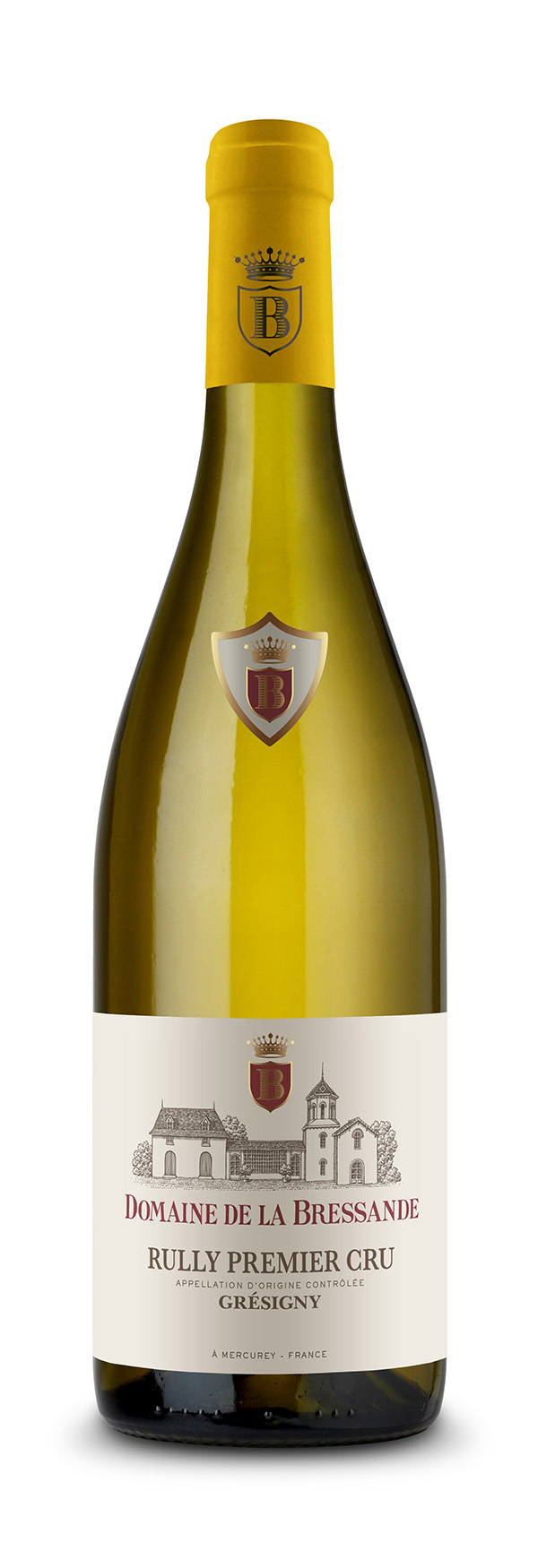RULLY PREMIER CRU
GRESIGNY 2021
Grape Variety
100% Chardonnay.
Tasting notes
Colour: beautiful golden yellow.
Nose: a pleasant bouquet blending notes of honey and toasted flowers.
Palate: a supple and rich wine on the palate after a floral attack on acacia and honey aromas.
Food and wine pairing
Will be perfect paired with cold meats, fine fish and seafood, but also hot starters, white meat in sauce and dry goat cheeses.
Serving suggestions
Serve ideally between 12° and 14°C / 54° and 57°F.
Ageing potential
5 years in average.
Origin
Rully is a communal appellation of the Côte Chalonnaise, south of Burgundy.
The appellation Rully is a communal appellation of the Côte Chalonnaise with 23 climates classified in 1er crus (30% of the parcel). 246 Ha are dedicated to white wines (with 69 Ha for the Premiers Crus) and 121 Ha are in red (28 Ha for the Premiers Crus).
Terroir
- Vineyard area: 0,7 Ha (1.73 acres).
- Vines age: around 27 years.
- Soil: Very calcareous brown and stony.
Vinification and maturing
Our Gresigny plot was hand-harvested on September, the 27th.
Pneumatic pressing followed by a cold settling between 12 and 24 hours, with the aim of eliminating the coarse bourbes (solid particles from the skin, stalks, skins, impurities that settle by sedimentation).
Alcoholic fermentation in thermo-regulated stainless steel vats for precise temperature control and homogeneity of the cuvée, followed by racking at the end of fermentation. Aging of the wines in 228 litre barrels (including 25% new barrels) on fine lees for 8 months.
Stirring: twice a month until malolactic fermentation (beginning of January) in order to develop complex aromas and preserve the purity of the fruit, to protect the wine from oxidation (barrel wall and bung hole) but also from reduction (accumulation of deposits, sometimes sulphurous, in the bottom of the barrel or vat), by putting the fine lees back into suspension.
Vintage : 2021
Nature certainly set a challenge for the winegrower and the winemaker with this vintage.
It began with very warm temperatures at the end of February which led to an early bud break.
The historic frost in April then destroyed young shoots that had emerged too early, significantly affecting the future harvest. Changing weather continued to characterize the vintage through to the harvests.
There were spells of rain from May to mid-August, obliging winegrowers to be constantly on the alert. The only periods of relative calm were during flowering, which took place in good conditions for the formation of the future fruit, and the véraison (colour change), which benefited from the return of the sun from mid-August.
The vagaries of the weather contributed to the development of outbreaks of disease, which were contained thanks to the tireless efforts of our winegrowers. In spite of this, considerable sacrifices had to be made to ensure a high level of quality, and rigorous sorting of the fruit in the vineyard and on arrival at the winery was necessary.
This vintage also required a major technical effort. The vinifications had to be carried out with meticulous attention and precision with a particular care over the extraction of colouring matter, the balance of the structure and the aromatic expression of the red wines, and of the freshness, balance of acidity and aromatic potential of the white wines.


